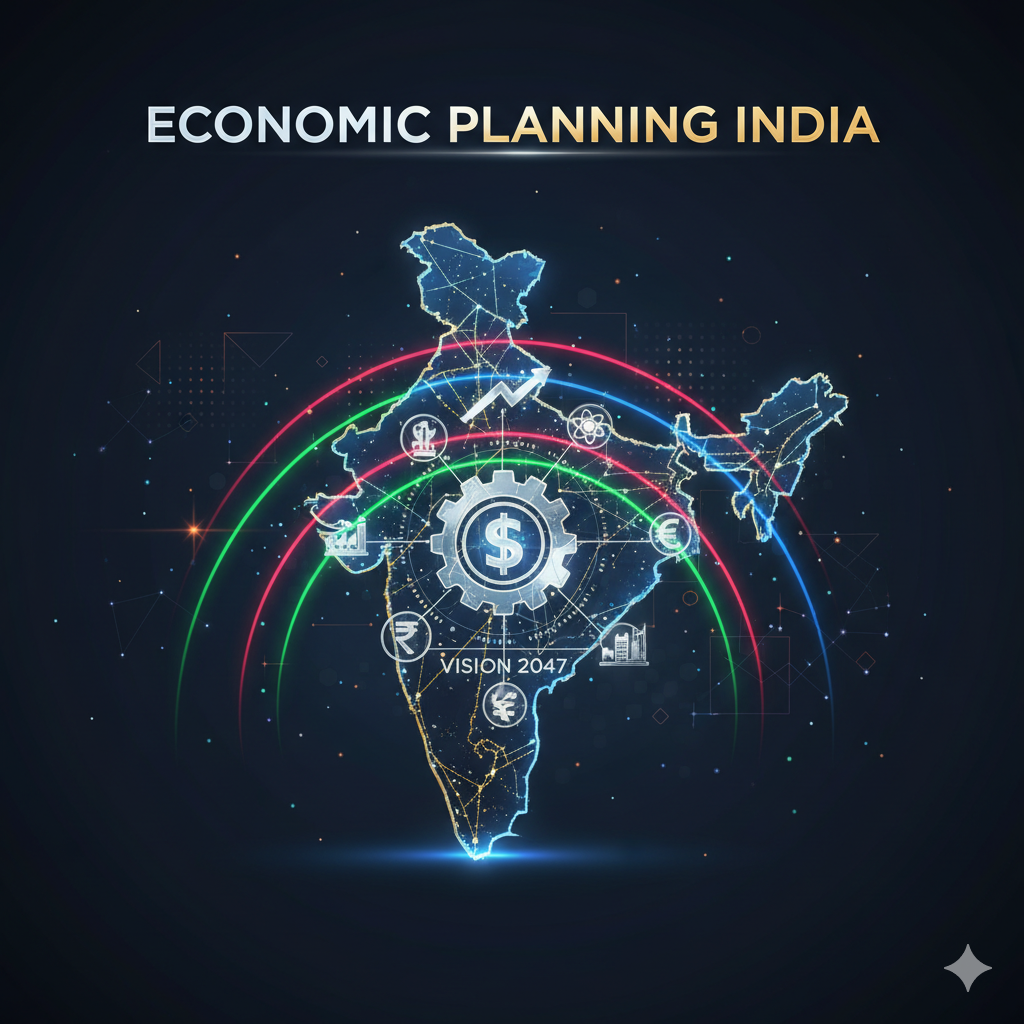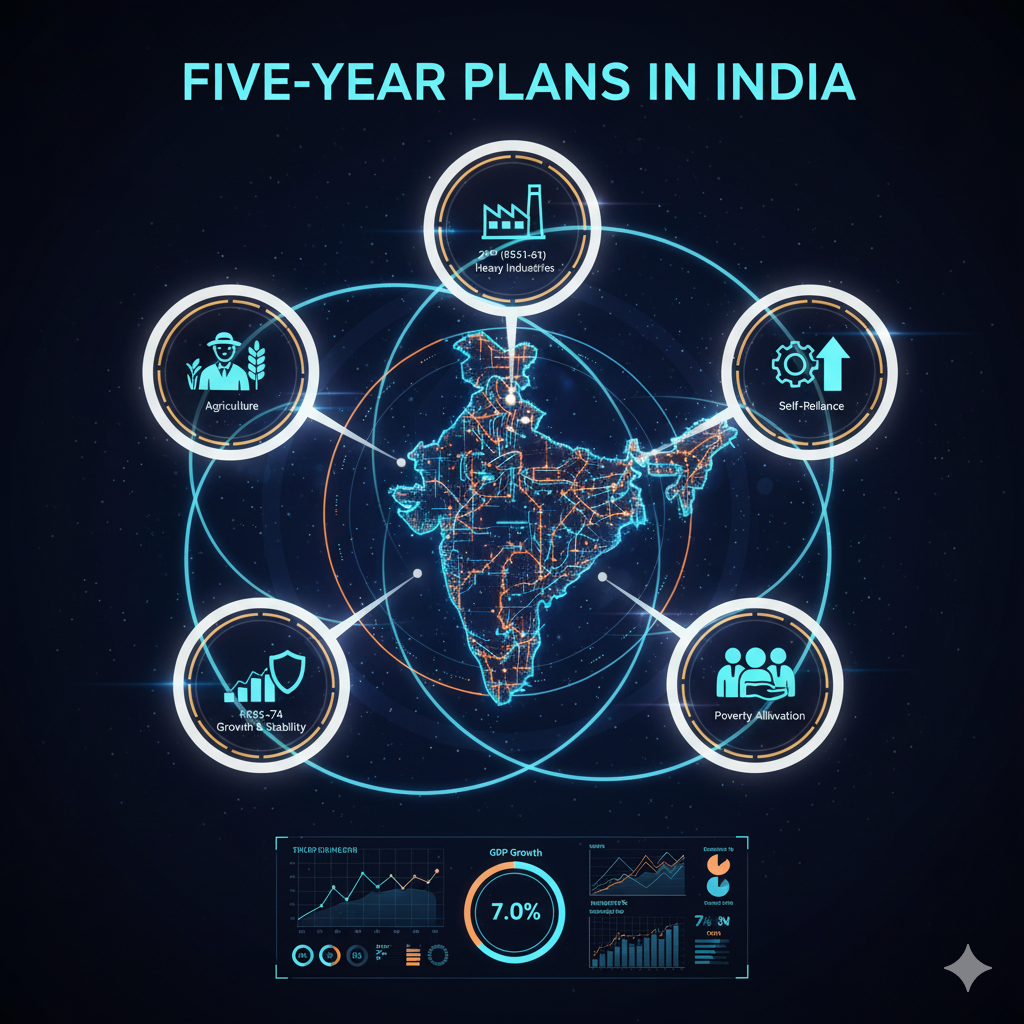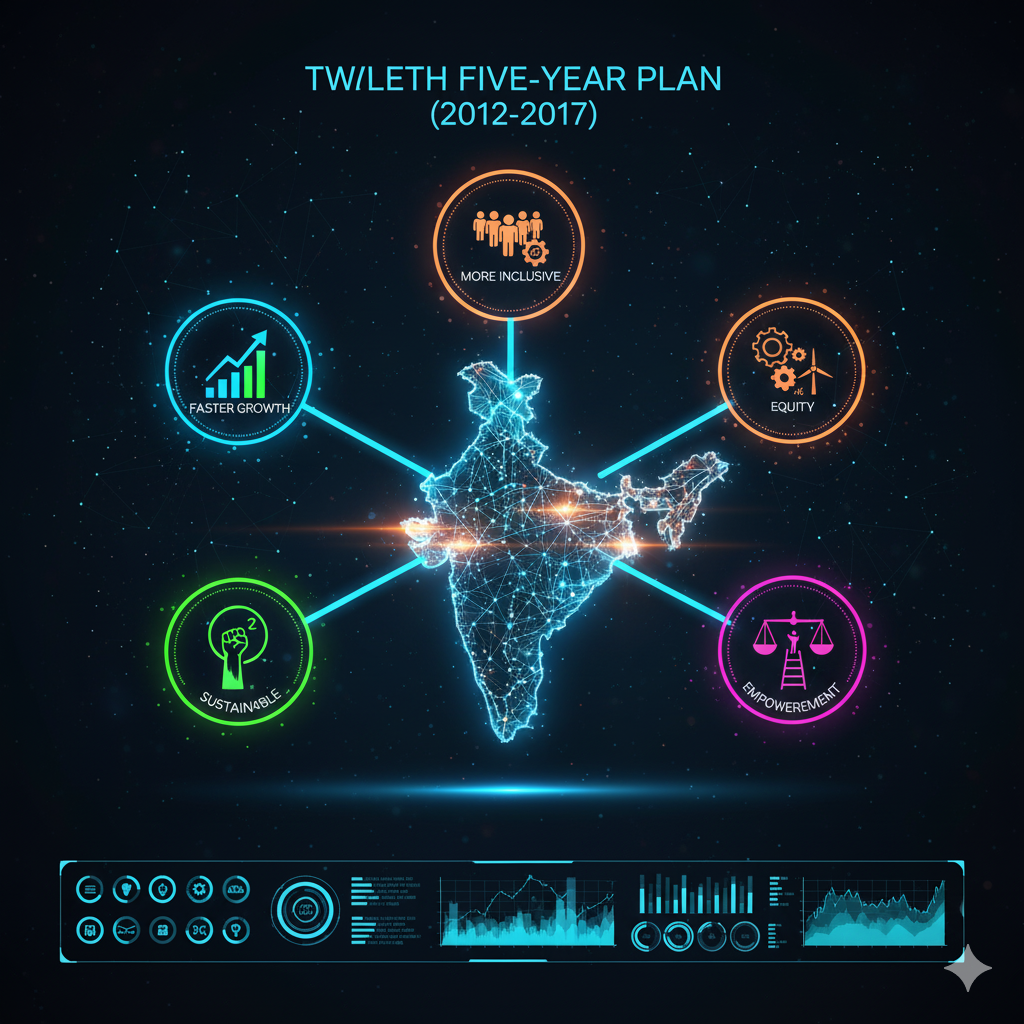Introduction
Economic planning has been the backbone of India’s developmental policy since independence. It refers to the systematic and deliberate allocation of resources by the government to achieve national goals like economic growth, poverty reduction, employment generation, and balanced regional development. However, achieving these goals required strategies — broad approaches that determine how the objectives of planning will be realized.
Over time, India has adopted different planning strategies in line with changing political priorities, economic realities, and global circumstances. From Nehru’s socialist-inspired industrialization strategy to Gandhian village-centric self-sufficiency, and later to Liberalization, Privatization, and Globalization (LPG), each strategy reflected India’s evolving economic philosophy.
This article explores the major strategies of economic planning in India — including the Nehru–Mahalanobis Strategy, Gandhian Strategy, LPG Strategy, and the types of economic planning, tracing their features, objectives, outcomes, and comparative importance.
Meaning of Strategy of Economic Planning
The strategy of economic planning means the broad approach or method adopted to achieve planned economic development. It provides the direction and framework for the formulation of Five-Year Plans and helps decide the priority sectors, resource allocation, and role of state versus market.
In simple words, a planning strategy answers questions like:
- Should the focus be on agriculture or industry?
- Should the public sector or private sector play a dominant role?
- Should the economy be controlled centrally or be market-driven?
Thus, a planning strategy acts as a blueprint for development, guiding policies and investments in line with national objectives.
Major Strategies of Economic Planning in India
1. Nehru–Mahalanobis Strategy
The Nehru–Mahalanobis Strategy was the dominant planning approach during the first three decades after independence, especially during the Second Five-Year Plan (1956–61). It was formulated under the guidance of Pandit Jawaharlal Nehru, India’s first Prime Minister, and Professor Prasanta Chandra Mahalanobis, a renowned statistician and economist.
a. Background
After gaining independence in 1947, India faced numerous economic challenges:
- Low industrial base
- Dependence on agriculture
- Shortage of capital and technology
- High unemployment and poverty
To address these issues, Nehru believed that rapid industrialization, particularly in the capital goods sector, was essential for achieving long-term self-reliant growth. Mahalanobis provided the mathematical model to operationalize this vision.
b. Core Ideas of the Strategy
- Emphasis on Heavy and Capital Goods Industries:
Investment should be directed toward industries producing machinery, steel, and power, which form the base for future industrialization. - Public Sector Dominance:
The state should play a leading role in establishing basic industries, as private investment was inadequate. - Long-Term Self-Reliance:
By producing capital goods domestically, India could reduce dependence on foreign imports. - Centralized Planning:
Resource allocation and investment decisions were to be made by a central authority (Planning Commission). - Industrialization as the Engine of Growth:
Industrial expansion would lead to employment generation and overall economic growth.
c. Implementation in the Second Five-Year Plan
The Second Plan (1956–61) was the operational phase of the Nehru–Mahalanobis model. Major public sector projects like Bhilai, Rourkela, and Durgapur steel plants, Heavy Engineering Corporation, and Bharat Heavy Electricals (BHEL) were established.
d. Achievements
- Built a strong industrial foundation for India.
- Promoted technological capability and import substitution.
- Expanded the public sector and infrastructure base.
e. Limitations
- Neglected the agricultural sector, leading to food shortages and inflation.
- Capital-intensive industries created limited employment.
- Resulted in inefficiency and bureaucratic delays.
- Increased dependence on imports for machinery and technology in early stages.
f. Significance
Despite its flaws, the Nehru–Mahalanobis strategy laid the foundation for India’s industrial economy and influenced policy for decades. It established the framework for state-led development, which remained dominant until the 1991 economic reforms.
2. Gandhian Strategy of Economic Planning
The Gandhian Strategy represents a contrasting vision of development — emphasizing decentralization, self-reliant villages, and moral economics. While it was never formally adopted as India’s national plan, Gandhian ideals deeply influenced many rural development programs and continue to shape India’s approach to sustainable growth.
a. Philosophy Behind the Strategy
Mahatma Gandhi believed that “real India lives in its villages.” Hence, the focus of economic development should be village reconstruction and rural empowerment, rather than large-scale industrialization.
He opposed excessive centralization, arguing that it alienates individuals and destroys local initiative.
b. Core Principles of the Gandhian Strategy
- Village-Centric Development:
Villages should be self-sufficient in basic needs — food, clothing, housing, and small industries. - Decentralization of Power:
Economic and political power should flow from the bottom up — through Gram Panchayats and local cooperatives. - Promotion of Cottage and Small Industries:
Handicrafts, handlooms, and village industries should be encouraged to generate rural employment. - Simplicity and Self-Reliance:
Gandhi emphasized simple living, minimal consumption, and reliance on local resources. - Moral and Humanistic Approach:
Economic progress should be based on ethics, non-violence, and human welfare rather than profit and materialism. - Sustainable Development:
Gandhi’s emphasis on harmony with nature anticipated modern concepts of sustainability and ecological balance.
c. The Gandhian Plan (1944)
Proposed by S.N. Agarwal, the Gandhian Plan was an early attempt to translate Gandhian philosophy into a practical economic program. It proposed:
- Emphasis on village industries and agriculture.
- Decentralized economy.
- Limited industrialization to meet basic needs.
- Employment generation through manual and small-scale work.
d. Relevance in Modern India
Even though India adopted the Nehru–Mahalanobis industrialization model, Gandhian ideas influenced later policies such as:
- Community Development Programme (1952)
- Integrated Rural Development Programme (IRDP)
- Khadi and Village Industries Commission (KVIC)
- Self-Help Groups (SHGs)
- Mahatma Gandhi National Rural Employment Guarantee Act (MGNREGA)
These programs embody the spirit of rural empowerment, decentralization, and self-sufficiency that Gandhi envisioned.
e. Evaluation
Strengths:
- Environmentally sustainable and labor-intensive.
- Promotes equitable distribution and local participation.
- Reduces rural-urban migration.
Weaknesses:
- Limited potential for rapid economic growth.
- Technological backwardness in small-scale sectors.
- Challenges in global competitiveness.
Despite these limitations, the Gandhian strategy remains relevant as a moral compass for inclusive and sustainable development.
3. LPG Strategy (Liberalization, Privatization, and Globalization)
The LPG Strategy marks a dramatic shift in India’s planning philosophy — from a state-controlled economy to a market-oriented, globally integrated economy. It emerged in response to the 1991 economic crisis, when India faced severe fiscal and balance-of-payment problems.
a. Background
By 1991, India’s economy was struggling due to:
- High fiscal deficit and debt.
- Declining foreign exchange reserves (barely enough for two weeks of imports).
- Inefficient public sector enterprises.
- Over-regulation and bureaucratic controls (License Raj).
To rescue the economy, the government under Prime Minister P.V. Narasimha Rao and Finance Minister Dr. Manmohan Singh introduced New Economic Policy (NEP) of 1991, guided by the LPG framework.
b. Core Components of the LPG Strategy
1. Liberalization
- Reduction of government control over industries and businesses.
- Simplification of licensing and regulatory procedures.
- Opening up sectors like banking, telecom, and aviation.
- Encouragement of competition and entrepreneurship.
2. Privatization
- Transfer of ownership or management of public enterprises to private hands.
- Disinvestment of government shares in PSUs (Public Sector Undertakings).
- Increased efficiency and profitability through private sector participation.
3. Globalization
- Integration of Indian economy with the global market.
- Promotion of exports and foreign direct investment (FDI).
- Adoption of international standards and technologies.
- Participation in global trade organizations like WTO.
c. Objectives of LPG Strategy
- Achieve rapid and sustainable growth.
- Enhance efficiency and productivity.
- Integrate India into the global economy.
- Reduce fiscal deficit and control inflation.
- Encourage private sector innovation and investment.
d. Achievements
- Accelerated Economic Growth:
Post-1991, India’s GDP growth averaged around 7% per annum. - Expansion of Service Sector:
IT, telecom, and financial services became key growth engines. - Increased Foreign Investment:
FDI inflows rose significantly, boosting industrial modernization. - Export Growth:
India became a major exporter of software, pharmaceuticals, and engineering goods. - Rising Middle Class:
Income levels and living standards improved for large sections of the population.
e. Challenges
- Rising Inequality: Growth benefits were unevenly distributed.
- Agricultural Distress: Agriculture lagged behind industry and services.
- Environmental Concerns: Rapid industrialization caused pollution and deforestation.
- Jobless Growth: Automation and capital-intensive industries limited job creation.
- Dependence on Global Markets: Increased vulnerability to external shocks.
f. Significance
The LPG strategy transformed India into one of the world’s fastest-growing economies. It redefined the role of the government from controller to facilitator, encouraging innovation, efficiency, and global integration. However, it also highlighted the need for inclusive policies to ensure equitable growth.
4. Types of Economic Planning
Economic planning can be classified based on different criteria such as control, flexibility, duration, and authority. Understanding these types helps in grasping the diversity of planning approaches adopted across countries and periods.
A. Based on the Nature of Control
1. Democratic Planning
- Conducted in democratic systems where public opinion and participation are valued.
- Implemented through elected representatives.
- Example: India’s planning system.
- Ensures transparency and accountability.
2. Totalitarian or Authoritarian Planning
- Conducted under centralized regimes with complete state control.
- Decisions are imposed from the top.
- Example: Former Soviet Union’s planning system.
B. Based on the Level of Control
1. Centralized Planning
- All decisions regarding investment, production, and distribution are taken by a central authority.
- Suitable for countries with limited administrative capacity at lower levels.
- Example: India’s Planning Commission era (1950–2014).
2. Decentralized Planning
- Local or regional authorities have a greater role in planning and implementation.
- Encourages local participation and better resource utilization.
- Example: Panchayati Raj institutions under NITI Aayog’s framework.
C. Based on Time Frame
1. Short-Term Plans
- Usually span 1 to 2 years.
- Focused on immediate goals like price stability or employment.
- Example: Annual Plans during plan holidays (1966–69).
2. Long-Term Plans
- Cover a period of 5 years or more.
- Aim at structural transformation and long-term development.
- Example: India’s Five-Year Plans.
D. Based on Flexibility
1. Rigid Planning
- No room for modification once the plan is launched.
- Suitable for stable and predictable economies.
- Example: Early Soviet-style plans.
2. Flexible Planning
- Plans can be revised according to changing conditions.
- Allows adaptation to unforeseen challenges.
- Example: India’s plans after the 4th Five-Year Plan adopted flexibility.
E. Based on Scope
1. Comprehensive Planning
- Covers all sectors — agriculture, industry, services, infrastructure, and social welfare.
- India’s Five-Year Plans followed this approach.
2. Sectoral Planning
- Focuses on a specific sector or area like agriculture, transport, or education.
- Example: National Education Policy or Agricultural Development Plans.
F. Based on Nature of Economic System
1. Indicative Planning
- Government provides guidelines and incentives rather than binding targets.
- Private sector participation is encouraged.
- Example: France and post-1991 India.
2. Imperative Planning
- Government dictates production, investment, and prices.
- Compulsory targets for all sectors.
- Example: Soviet Union.
Comparative Overview of Major Strategies
| Aspect | Nehru–Mahalanobis Strategy | Gandhian Strategy | LPG Strategy |
|---|---|---|---|
| Focus | Industrialization | Rural self-sufficiency | Market efficiency |
| Model | Socialist, state-led | Decentralized, moral | Market-oriented |
| Main Sector | Heavy industries | Agriculture, cottage industries | Services and private sector |
| Role of State | Dominant | Minimal | Facilitator |
| Outcome | Industrial base | Rural empowerment | Global integration |
| Limitation | Neglect of agriculture | Low growth potential | Inequality, jobless growth |
Conclusion
The evolution of planning strategies in India reflects the country’s continuous effort to balance growth, equity, and sustainability.
- The Nehru–Mahalanobis Strategy built India’s industrial backbone and self-reliance.
- The Gandhian Strategy offered a moral and human-centered vision emphasizing village empowerment and ecological balance.
- The LPG Strategy opened India to global opportunities, ushering in rapid modernization and competitiveness.
Each strategy contributed uniquely to India’s developmental journey. Today’s planning under NITI Aayog seeks to integrate the strengths of all — industrial growth, rural inclusion, and global connectivity — within a sustainable and digitally empowered framework for “New India @2047.”
Summary Points
- Planning Strategy: The method of achieving developmental goals.
- Nehru–Mahalanobis Strategy: Focus on heavy industries and state-led growth.
- Gandhian Strategy: Emphasized village self-sufficiency and decentralized planning.
- LPG Strategy: Promoted liberalization, privatization, and globalization after 1991.
- Types of Planning: Centralized, decentralized, indicative, comprehensive, rigid, flexible, short-term, and long-term.
- Modern Planning: Combines sustainability, inclusion, and technology-driven growth.




